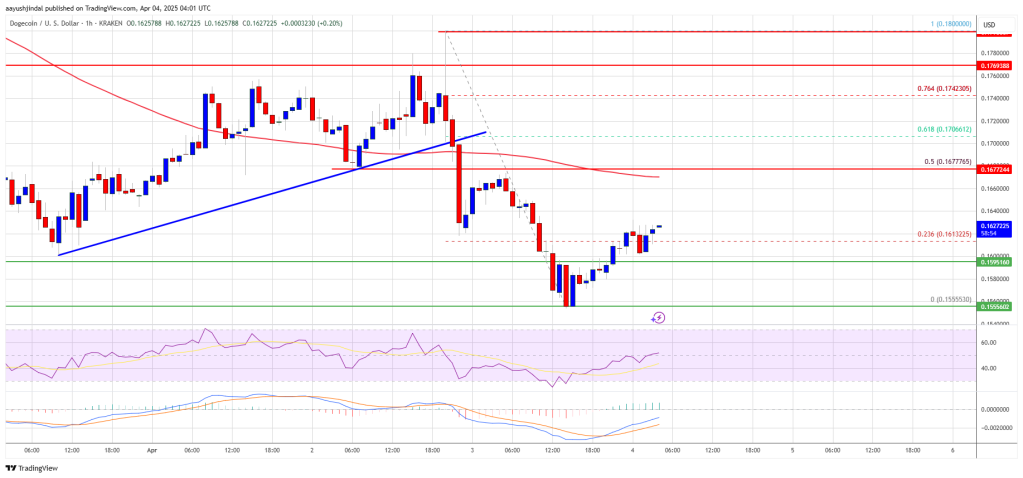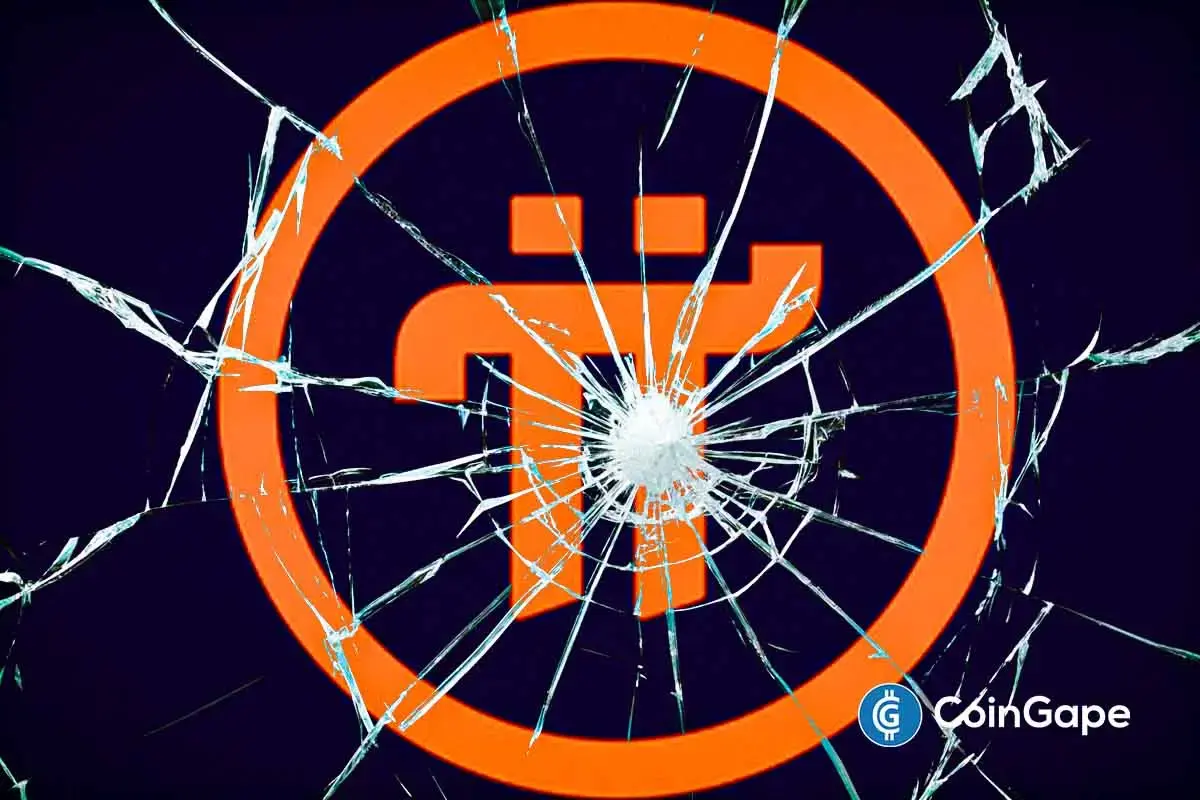Market
The rise of neo-banking and its role in banking the underbanked
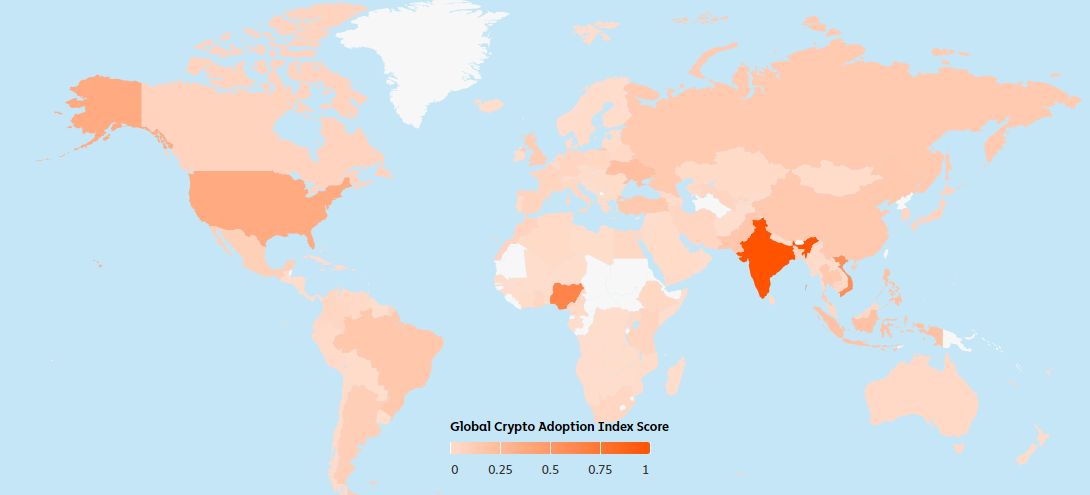

Emerging nations are the fastest growing regions in crypto adoption and the growing presence of neo-banks plays the biggest role in this growth. Could these innovative platforms be the solution to financial inequalities and the lack of adequate banking services for over one billion people?
As Satoshi once remarked in his now-stopped social messages, “Bitcoin would be convenient for people who don’t have a credit card or don’t want to use the cards they have”. Emerging nations whether in Africa, Latin America or South East Asia could resonate more truly to this statement than others. Over the past half-decade, the growth of neo-banks in developing countries has caused a revolutionary change in how the populous interact in their economies and a radical change in their financial systems.
Crucially, the billions of unbanked and underbanked are finally integrated into the global financial systems, despite the lack of efficient banking structures in their respective nations.
This article will break down how cryptocurrency is benefiting the unbanked (and underbanked) and the role neo-banks play in providing financial services to countries with little hope of having a stable banking infrastructure. The piece further looks at the role developing countries play in growing the crypto ecosystem and various technological advancements in the industry as a result of rapid adoption across Sub-Saharan Africa, Latin America and Southeast Asia regions.
Financial Inequality in Underserved Economies
According to World Bank reports, over 1.2 billion people across the world are either unbanked or underbanked. Developing countries remain the most affected nations with over 50% of the population having little to no access to solid banking infrastructure or basic financial services such as loaning facilities, savings accounts, etc.
The advent of blockchain technology and cryptocurrencies sparked a drastic change in the global financial system, providing previously unavailable financial systems to citizens of these nations. The emergence of this decentralized industry is becoming a force in the global financial landscape, redefining traditional currency, transactions, and financial systems.
Cryptocurrencies, powered by blockchain technology and cryptographic principles, are opening up the financial world to developing nations, allowing previously unbanked and underbanked citizens to participate in the financial ecosystem. These assets have opened up new avenues to transact and store value by giving everyone access to fast and low-cost digital cash that can be spent anywhere.
The Rise of Neo-Banks and Decentralized Finance (DeFi)
The global financial crisis in 2008 brought rise to several innovations in the industry, majorly the growth of neo-banking. Neo-banks refer to financial technology firms that are redefining how banking services are delivered to consumers, from seamless digital experiences to lower transaction fees and accessibility via smartphones, etc.
The most prominent form of neo-banking arose in Kenya, with the launch of M-Pesa, a mobile-based financial service that allowed anyone with a SIM card and a phone to send and receive money. Over the years, such innovations have evolved into formidable players in the financial sector, as they revolutionize traditional banking and financial services.
Recently, decentralized finance (DeFi) apps have come to the fore, providing digital and decentralized alternatives that offer personalised user-centric services that resonate with crypto-savvy consumers. Notwithstanding, crypto exchange apps have sprouted rapidly offering anyone across the world an opportunity to access cryptocurrencies directly on their smartphones. These apps ensure advanced security measures, and seamless integration of fintech solutions, setting them apart from traditional finance services.
As such, developed countries have been able to join the global financial systems, signifying a paradigm shift in the transformative power of crypto for the modern consumer.
Crypto Exchanges May Challenge The Status Quo
As alluded to, crypto exchanges are diversifying to wider markets, moving from simple on-ramp and off-ramping business models to becoming neo-banks and challenging the traditional finance system – global, low-cost and very accessible to the unbanked. Crypto adoption is becoming more prominent for the 1.2 billion and financial services and products are more sophisticated and accessible. Could this pose a threat to the traditional banking systems?
The jury is still out on that but the solutions provided by these “decentralized neo-banks” are having a great effect on emerging nations’ economies – financial inclusion, low-cost remittance fees, and fast and secure transactions have driven the growth of crypto in these economies.
Boxwind, a digital asset exchange platform set to launch later in the year, brings these solutions to the 1.2 billion who need such services. From trading to lending, saving, trading, and a channel to affordably transfer crypto cryptocurrencies into and around emerging economies. The exchange is designed with advanced functionalities for new and experienced investors, providing spot and derivatives trading of over 300+ digital assets, on-ramp and off-ramp solutions, staking services, borrowing/lending and much more.
The platform also features its brainchild, PIP World, a service that aims to empower users via Edutech programs, gamified trading, and AI-powered gaming. PIP Trader, one of the gamefied and educative platforms, allows users to team up, battle in trading games, and earn rewards on an AI-powered game.
Looking Ahead
Chainalysis’ 2023 Crypto Report showed that over 40% of the world’s cryptocurrency users reside in lower-middle-income countries (LMICs), with the number growing every year. This impressive growth is heavily influenced by CEXs and the vast services they offer. Regulated crypto exchanges could be the main driver of sustained adoption rates by facilitating neo-banking services to the underbanked.
Crypto adoption in emerging economies presents a unique opportunity to empower individuals, enhance skills and financial literacy, and provide solutions to financial inequalities. For the industry to really grow, however, several things must be put in place including setting up secure platforms, regulatory compliance, users’ funds protection, easily accessible platforms, and educating the masses on the technology.
Market
What to Expect on May 7

The highly anticipated Pectra upgrade will launch on the Ethereum (ETH) mainnet on May 7, 2025, after overcoming a series of technical challenges and delays in the testnet phase.
Ethereum developers announced the date during the All Core Developers Consensus (ACDC) meeting on April 3, 2025.
Pectra Upgrade Countdown Begins
The upgrade was initially slated for a tentative mainnet launch on April 30. However, Ethereum developers have postponed the launch by one week.
“We’ll go ahead and lock in May 7 for Pectra on mainnet,” Ethereum Foundation researcher Alex Stokes said.
In preparation for this, Stokes confirmed that client releases will be made available by April 21, ensuring that all users have the necessary updates and tools ahead of the mainnet launch. On April 23, a detailed blog post outlining the Pectra mainnet will be published.
The Pectra upgrade will introduce 11 Ethereum Improvement Proposals (EIPs) to enhance various aspects of the network. Notably, three EIPs are dedicated to improving the validator experience.
The first is EIP-7251. This will increase the staking limit for validators from 32 ETH to 2,048 ETH per validator. This change aims to enhance capital efficiency for large stakers and staking pools.
“This simplifies the staking experience, allowing users to manage multiple validators under one node instead of several,” an analyst remarked.
Moreover, EIP-7002 introduces execution-layer triggerable withdrawals, giving validators more control. Meanwhile, EIP-6110 reduces the deposit processing delay from about 9 hours to just 13 minutes.
The upgrade will also include EIP-7702, a major step toward account abstraction. It allows Externally Owned Accounts (EOAs) to gain smart contract functionality while maintaining simplicity. This enables features like transaction batching, gas sponsorship (where third parties pay fees), passkey-based authentication, spending controls, and asset recovery mechanisms.
Finally, the upgrade increases blob capacity through EIP-7691. In addition, EIP-7623 helps manage the increased bandwidth requirements. These updates aim to make Ethereum more scalable, efficient, and user-friendly.
It is worth noting that the road to the mainnet launch has not been without hurdles. Two previous tests on the Holesky and Sepolia test networks failed to finalize properly. However, Pectra achieved full finalization on the Hoodi testnet on March 26, marking a significant milestone toward the successful deployment of the upgrade.
Despite the technical progress, ETH continues to face market challenges.

Data from BeInCrypto shows that ETH dropped 4.8% over the past week, with weekly losses extending to 17.1%. At the time of writing, the altcoin was trading at $1,822, reflecting a small daily gain of 0.8%.
Disclaimer
In adherence to the Trust Project guidelines, BeInCrypto is committed to unbiased, transparent reporting. This news article aims to provide accurate, timely information. However, readers are advised to verify facts independently and consult with a professional before making any decisions based on this content. Please note that our Terms and Conditions, Privacy Policy, and Disclaimers have been updated.
Market
XRP Futures and Illinois Lawsuit Relief

Coinbase filed with the US Commodity Futures Trading Commission (CFTC) to launch futures contracts for Ripple’s XRP token.
The move comes after a positive development for the crypto derivatives market in the US, reflecting shifting regulatory ties in the country.
Coinbase Files for XRP Futures Trading With CFTC
Coinbase Derivatives has submitted a filing to self-certify XRP futures. It will provide a regulated, capital-efficient means for market participants to gain exposure to XRP. The new contract could go live as soon as April 21.
“We’re excited to announce that Coinbase Derivatives has filed with the CFTC to self-certify XRP futures – bringing a regulated, capital-efficient way to gain exposure to one of the most liquid digital assets. We anticipate the contract going live on April 21, 2025,” read the announcement.
Meanwhile, the official filing indicates that the XRP futures contract will be a monthly cash-settled and margined contract trading under the symbol XRL.
Each contract represents 10,000 XRP and will be settled in US dollars. Trading will be available for the current month and two subsequent months. As a protective measure, trading will be temporarily halted if the spot XRP price moves more than 10% within an hour.
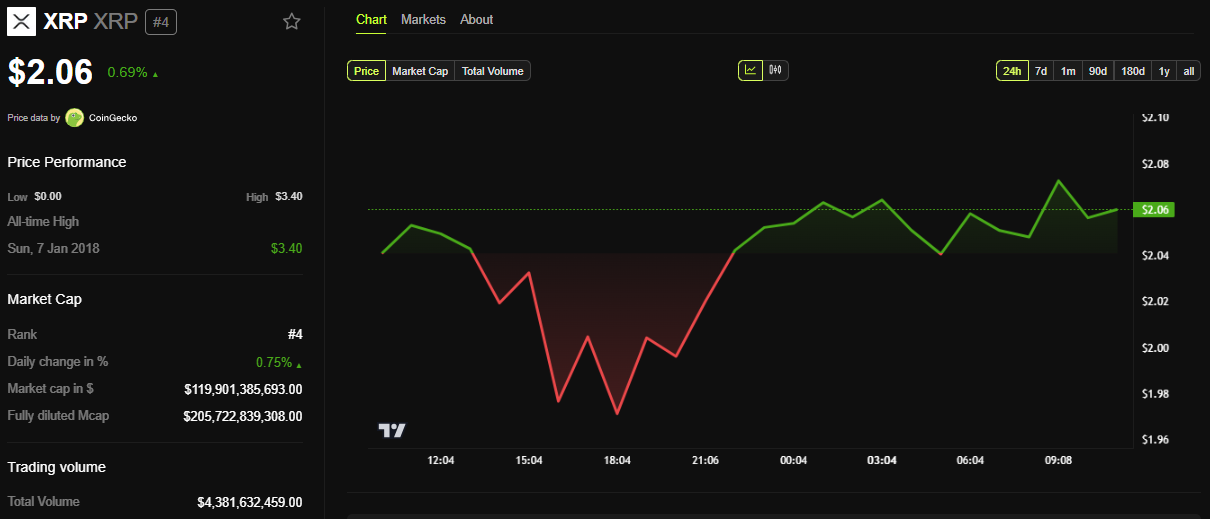
The Coinbase Exchange also confirmed that it has engaged with Futures Commission Merchants (FCMs) and other market participants. Both references reportedly expressed support for the launch.
However, Coinbase is not the first US-based exchange to introduce regulated XRP futures. In March, Chicago-based Bitnomial launched what it advertised as the country’s first CFTC-regulated XRP futures contract.
For Coinbase, however, the boldness comes after the CFTC eased key regulatory hurdles for crypto derivatives trading. As BeInCrypto reported, this signaled a more accommodating stance towards the sector.
“Pursuant to Commodity Futures Trading Commission (“CFTC” or “Commission”) Regulation 40.2(a), Coinbase Derivatives, LLC (the “Exchange” or “COIN”) hereby submits for self-certification its initial listing of the XRP Futures contract to be offered for trading on the Exchange…,” an excerpt in the filing indicated.
This suggests that the commodities regulator’s shift, revoking previous crypto-related guidelines, may boost institutional confidence. For XRP, this development bolsters confidence in the asset’s previously contentious status following Ripple’s recent regulatory breakthrough.
“Coinbase Derivatives’ filing with the CFTC to self-certify XRP futures aims to legitimize XRP trading by offering a regulated, capital-efficient product for investors,” one user remarked.
The futures contract might also help the odds of XRP ETF approval. Recently, the SEC delayed several applications to create one, and its status is in limbo.
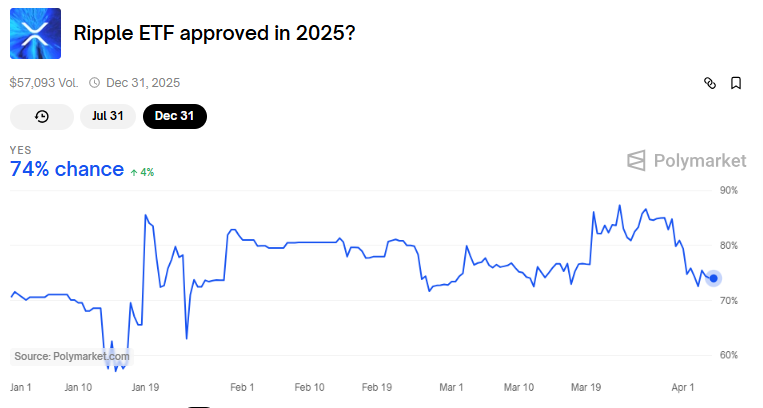
Data on Polymarket shows bettors see a 74% chance for XRP ETF approval in 2025 and a more modest 34% by July 31.
Regulatory and Legal Developments Favor Coinbase
Elsewhere, the timing of this filing aligns with recent favorable regulatory developments for Coinbase. Reports suggest Illinois intends to drop its lawsuit against the exchange over its staking services.
Up to 10 states filed a lawsuit against Coinbase in June 2023 alleging that its staking program constituted unregistered securities offerings.
This recent development makes Illinois the fourth state to withdraw legal action against Coinbase. Vermont, South Carolina, and Kentucky also dismissed their cases on March 13, 27, and 31, respectively.
However, the cases remain active in Alabama, California, Maryland, New Jersey, Washington and Wisconsin.
These legal retreats coincide with the US SEC’s (Securities and Exchange Commission) February decision to abandon its federal lawsuit against Coinbase. BeInCrypto reported that this development marked a broader shift in the regulatory approach under the current administration.
“Regulators are losing steam, and Coinbase is stacking quiet courtroom wins. Staking’s future in the US might just be back on track,” a user commented.
Illinois’ decision to drop its lawsuit comes as the state advances a Bitcoin strategic reserve bill. Specifically, Illinois State Representative John M. Cabello introduced House Bill 1844 (HB1844), highlighting Bitcoin’s potential as a decentralized, finite digital asset.
“A strategic bitcoin reserve aligns with Illinois’ commitment to fostering innovation in digital assets and providing Illinoisans with enhanced financial security,” the bill read.
Disclaimer
In adherence to the Trust Project guidelines, BeInCrypto is committed to unbiased, transparent reporting. This news article aims to provide accurate, timely information. However, readers are advised to verify facts independently and consult with a professional before making any decisions based on this content. Please note that our Terms and Conditions, Privacy Policy, and Disclaimers have been updated.
Market
Dogecoin (DOGE) Bleeds Further—Fresh Weekly Lows Test Investor Patience

Dogecoin started a fresh decline from the $0.180 zone against the US Dollar. DOGE is consolidating and might struggle to recover above $0.1680.
- DOGE price started a fresh decline below the $0.1750 and $0.170 levels.
- The price is trading below the $0.1680 level and the 100-hourly simple moving average.
- There was a break below a key bullish trend line forming with support at $0.170 on the hourly chart of the DOGE/USD pair (data source from Kraken).
- The price could extend losses if it breaks the $0.1550 support zone.
Dogecoin Price Dips Again
Dogecoin price started a fresh decline after it failed to clear $0.180, like Bitcoin and Ethereum. DOGE dipped below the $0.1750 and $0.1720 support levels.
There was a break below a key bullish trend line forming with support at $0.170 on the hourly chart of the DOGE/USD pair. The bears were able to push the price below the $0.1620 support level. It even traded close to the $0.1550 support.
A low was formed at $0.1555 and the price is now consolidating losses. There was a minor move above the 23.6% Fib retracement level of the downward move from the $0.180 swing high to the $0.1555 low.
Dogecoin price is now trading below the $0.170 level and the 100-hourly simple moving average. Immediate resistance on the upside is near the $0.1650 level. The first major resistance for the bulls could be near the $0.1680 level. It is near the 50% Fib retracement level of the downward move from the $0.180 swing high to the $0.1555 low.
The next major resistance is near the $0.1740 level. A close above the $0.1740 resistance might send the price toward the $0.180 resistance. Any more gains might send the price toward the $0.1880 level. The next major stop for the bulls might be $0.1950.
Another Decline In DOGE?
If DOGE’s price fails to climb above the $0.170 level, it could start another decline. Initial support on the downside is near the $0.160 level. The next major support is near the $0.1550 level.
The main support sits at $0.150. If there is a downside break below the $0.150 support, the price could decline further. In the stated case, the price might decline toward the $0.1320 level or even $0.120 in the near term.
Technical Indicators
Hourly MACD – The MACD for DOGE/USD is now losing momentum in the bearish zone.
Hourly RSI (Relative Strength Index) – The RSI for DOGE/USD is now above the 50 level.
Major Support Levels – $0.1600 and $0.1550.
Major Resistance Levels – $0.1680 and $0.1740.
-

 Market24 hours ago
Market24 hours agoIP Token Price Surges, but Weak Demand Hints at Reversal
-

 Ethereum23 hours ago
Ethereum23 hours agoEthereum Trading In ‘No Man’s Land’, Breakout A ‘Matter Of Time’?
-

 Market20 hours ago
Market20 hours agoBitcoin’s Future After Trump Tariffs
-

 Regulation19 hours ago
Regulation19 hours agoUS Senate Banking Committee Approves Paul Atkins Nomination For SEC Chair Role
-

 Altcoin24 hours ago
Altcoin24 hours agoMovimiento millonario de Solana, SOLX es la mejor opción
-

 Bitcoin23 hours ago
Bitcoin23 hours agoBlackRock Approved by FCA to Operate as UK Crypto Asset Firm
-

 Market23 hours ago
Market23 hours agoHBAR Foundation Eyes TikTok, Price Rally To $0.20 Possible
-

 Altcoin23 hours ago
Altcoin23 hours agoJohn Squire Says XRP Could Spark A Wave of Early Retirements











